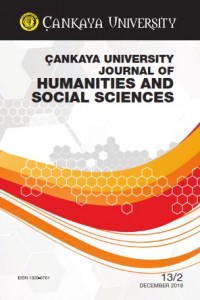Enlightenment, Utopia and Encarnalization of Swift’s Houyhnhnms in Carter’s Desire Machines of Doctor Hoffman
Abstract
In Dialectic of Enlightenment Max Horkheimer and Theodore Adorno trace the roots of modern bourgeois thought in the Enlightenment ideology that is characterized by the effort of establishing order over nature and that dates back to Odyssey. They argue that the whole human history has been motivated by the fetishism of ‘truth’ and ‘facts,’ devaluation of nature, a fear of social deviation. Well-known utopian works such as Plato’s The Republic, Augustine’s The City of God, and Thomas More’s Utopia represent this ‘fear of social deviation’ and ‘devaluation of nature.’ The Fourth Part of Jonathan Swift’s Gulliver’s Travels, entitled “A Voyage to the Country of the Houyhnhnms,” is a utopian work in which a horse-race called ‘Houyhnhnms’ creates such logocentric system based on the ‘fear of social deviation’ and on the control of nature and the carnal. In The Infernal Desire Machines of Doctor Hoffman Angela Carter parodies the logocentric world of Swift’s Houyhnhnms. In the chapter entitled “Lost in Nebulous Time,” which is an overt parody of Swift’s the “Country of Houyhnhnms,” centaurs which are half horse and half human creatures are depicted as extremely involved in carnal desires and as having an innate tendency for evil. The article handles the logocentric enlightenment discourse represented in Swift’s “A Voyage to the Country of the Houyhnhnms” and studies how in “Lost in Nebulous Time” of The Infernal Desire Machines of Doctor Hoffman Angela Carter parodies Swift’s utopia by carnalizing and carnivalizing it.
References
- Augustine, Saint. Confessions. Oxford UP, 2000.
- Bakhtin, Mikhail. The Dialogic Imagination. University of Texas P, 1983.
- Carter, Angela. The Infernal Desire Machines of Doctor Hoffman. Penguin Classics, 2011.
- ---. The Sadeian Woman: An Exercise in Cultural History. Virago, 1979.
- Derrida, Jacques. “Structure, Sign, and Play in the Discourse of the Human Sciences.” The Critical Tradition: Classic Texts and Contemporary Trends, edited by David H. Richter, St. Martin’s P., 1989, pp.963-71.
- Foucault, Michel. The History of Sexuality: An Introduction. Vintage Books, 1978.
- ---. The History of Sexuality: The Use of Pleasure. Vintage Books, 1985.
- Frank, Joseph. The Idea of Spatial Form. Rutgers UP, 1991.
- Hammond, Eugene. R. “Nature-Reason-Justice in Utopia and Gulliver’s Travels.” Studies in English Literature, vol. 22, no. 3, 1982, pp.445-68. https://www.jstor.org/stable/pdf/450241.pdf?refreqid=excelsior%3Ae7b8352fcd4f5e61d8f43ddfc41ae206. Accessed 25 December 2019.
- Horkheimer, Max and Theodore W. Adorno. Dialectic of Enlightenment. Edited by Gunzelin Schmid Noerr. Translated by Edmund Jephcott ed. By. Stanford UP, 2002.
- Houston, Chlöe. “Utopia, Dystopia or Anti-Utopia? Gulliver’s Travels and the Utopian Mode of Discourse.” Utopian Studies, vol. 18, no.3, 2007, pp.425-42, https://www.jstor.org/stable/pdf/20719885.pdf. Accessed 25 December 2019.
- Kestner, Joseph. “Secondary Illusion: The Novel and the Spatial Arts.” Spatial Form in Narrative, edited by J. R. Smitten and A. Daghistany. Cornell UP, 1981.
- Kilic, Mine O. Gender-Bending Fantasies in Women’s Writing. VDM Verlag, 2009.
- Lessing, G. E. Laocoön: An Essay on the Limits of Painting and Poetry. Translated by E. A. McCormick. The John Hopkins UP, 1984.
- Masamune, Satoshi. “Timelessness in Angela Carter’s The Infernal Desire Machines of Doctor Hoffman.” Shiron, vol. 42, 2004, pp.75-97, http://hdl.handle.net/10097/57598. Accessed 25 December 2019.
- Plato. Phaedo. Translated with notes by David Gallop, Clarendon P, 1975.
- Sellberg, Katin. “Embodied Platonisms: The Erotic Choreographies of Angela Carter and John Cameron Mitchell.” Corporeality and Culture, edited by Karin Sellberg et al.,. Ashgate, 2015, pp.95-108.
- Swift, Jonathan. Gulliver’s Travels. Penguin Classics, 1967.
Abstract
References
- Augustine, Saint. Confessions. Oxford UP, 2000.
- Bakhtin, Mikhail. The Dialogic Imagination. University of Texas P, 1983.
- Carter, Angela. The Infernal Desire Machines of Doctor Hoffman. Penguin Classics, 2011.
- ---. The Sadeian Woman: An Exercise in Cultural History. Virago, 1979.
- Derrida, Jacques. “Structure, Sign, and Play in the Discourse of the Human Sciences.” The Critical Tradition: Classic Texts and Contemporary Trends, edited by David H. Richter, St. Martin’s P., 1989, pp.963-71.
- Foucault, Michel. The History of Sexuality: An Introduction. Vintage Books, 1978.
- ---. The History of Sexuality: The Use of Pleasure. Vintage Books, 1985.
- Frank, Joseph. The Idea of Spatial Form. Rutgers UP, 1991.
- Hammond, Eugene. R. “Nature-Reason-Justice in Utopia and Gulliver’s Travels.” Studies in English Literature, vol. 22, no. 3, 1982, pp.445-68. https://www.jstor.org/stable/pdf/450241.pdf?refreqid=excelsior%3Ae7b8352fcd4f5e61d8f43ddfc41ae206. Accessed 25 December 2019.
- Horkheimer, Max and Theodore W. Adorno. Dialectic of Enlightenment. Edited by Gunzelin Schmid Noerr. Translated by Edmund Jephcott ed. By. Stanford UP, 2002.
- Houston, Chlöe. “Utopia, Dystopia or Anti-Utopia? Gulliver’s Travels and the Utopian Mode of Discourse.” Utopian Studies, vol. 18, no.3, 2007, pp.425-42, https://www.jstor.org/stable/pdf/20719885.pdf. Accessed 25 December 2019.
- Kestner, Joseph. “Secondary Illusion: The Novel and the Spatial Arts.” Spatial Form in Narrative, edited by J. R. Smitten and A. Daghistany. Cornell UP, 1981.
- Kilic, Mine O. Gender-Bending Fantasies in Women’s Writing. VDM Verlag, 2009.
- Lessing, G. E. Laocoön: An Essay on the Limits of Painting and Poetry. Translated by E. A. McCormick. The John Hopkins UP, 1984.
- Masamune, Satoshi. “Timelessness in Angela Carter’s The Infernal Desire Machines of Doctor Hoffman.” Shiron, vol. 42, 2004, pp.75-97, http://hdl.handle.net/10097/57598. Accessed 25 December 2019.
- Plato. Phaedo. Translated with notes by David Gallop, Clarendon P, 1975.
- Sellberg, Katin. “Embodied Platonisms: The Erotic Choreographies of Angela Carter and John Cameron Mitchell.” Corporeality and Culture, edited by Karin Sellberg et al.,. Ashgate, 2015, pp.95-108.
- Swift, Jonathan. Gulliver’s Travels. Penguin Classics, 1967.
Details
| Primary Language | English |
|---|---|
| Subjects | Literary Studies |
| Journal Section | Articles |
| Authors | |
| Publication Date | December 31, 2019 |
| Published in Issue | Year 2019 Volume: 13 Issue: 2 |
Çankaya University Journal of Humanities and Social Sciences
General Manager | Genel Yayın Yönetmeni, Öğretmenler Caddesi No.14, 06530, Balgat, Ankara.
Communication | İletişim: e-mail: mkirca@gmail.com | mkirca@cankaya.edu.tr
https://cujhss.cankaya.edu.tr/
CUJHSS, eISSN 3062-0112


